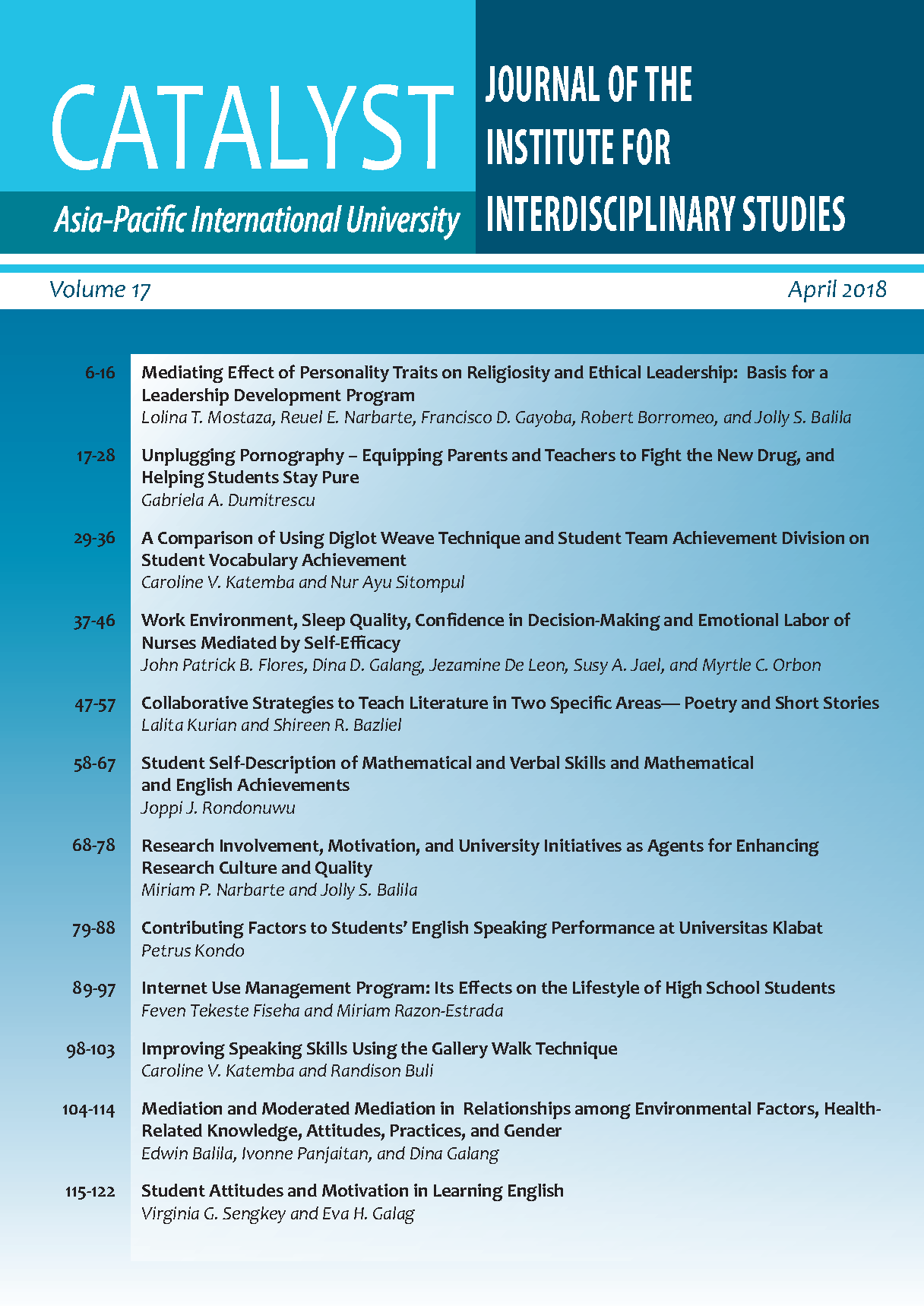Student Self-Description of Mathematical and Verbal Skills and Mathematical and English Achievements
Main Article Content
Abstract
This study analyzed and described the respondents’ self-description of mathematical and verbal skills, together with mathematical and English Language achievements, among 90 male and 90 female students at a private high school in Indonesia. Correlations of both mathematical and verbal skills with both mathematics and English achievements were investigated, along with the size of their effect. The findings showed that the students had average levels of mathematical and verbal skills, an above average level of mathematics achievement, and an average level of English achievement. Significant differences were found in the self-description of verbal and mathematical skills, and the achievements in an English subject for female and male students. Female students returned significantly higher scores for their self-description of verbal skill as well as English achievement, while male students did so only for their self-description of mathematical skill. Both self-description of mathematical and verbal skills simultaneously had a positive and significant association with mathematics and English achievement.
Article Details

This work is licensed under a Creative Commons Attribution-NonCommercial-NoDerivatives 4.0 International License.
Copyright: Asia-Pacific International University reserve exclusive rights to publish, reproduce and distribute the manuscript and all contents therein.
References
American Heritage. (2012). Verbal. Retrieved from http://americanheritage.yourdictionary.com/verbal.
Asbury University. (2012). Mathematic courses. Retrieved from http:www.asbury.edu/academics/ departments/mathematics/courses.
Begum, S., & Phukan, M. (2001). Academic achievement and intelligence: A correlational study in boy and girls. Indian Psychological Review, 56(2), 103-105.
Bradie, B. (2006). A friendly introduction to numerical analysis. USA: Pearson education, Inc.
Chambers, P. (2008). Teaching mathematics. England: British Library.
Ellis, L. A., Marsh, H. W., & Richards, G. E. (2002). A brief version of the Self-Description Questionnaire II. Paper presented at the SELF Research Centre International Conference, Sydney, Australia. Retrieved from http://edweb.uws.edu.au/self/
Elster, C. H. (2000). Verbal advantage: Ten easy steps to a powerful vocabulary. New York: Random House, Inc.
Gardner, H. (1999). Intelligence reframed: Multiple intelligences for 21st century. New York: Basic Books.
Gilman, R., & Moody, L. (1984). What practitioners say about listening: Research implications for the classroom. Foreign Language Annals, 17(3), 331-334. Retrieved from http://www.llas.ac.uk/ resources/gpg/67.
Gunning, T. (1996). Creating reading instruction for all children. Boston: Allyn and Bacon.
Isaken, S., Dorval, K., & Treffinger, D. (2010). Creative approaches to problem solving: A framework for innovation and change (3rd ed.). USA: SAGE publication, Inc.
Karthigeyan, K. & Nirmala, K. (2012). Academic achievement in English: an analysis through gender lens. MIER Journal of Educational Studies, Trends & Practices, 2(2), 144-157.
Kitao, S. (1990). Textual schemata and English language learning. Virginia: Pitt Street.
Körtesi, P., & Georgieva, D. (2015). Development of mathematical skills with commonly used computer software. Retrieved from http://www.unimiskolc.hu/~microcad/publikaciok/2015/C2_7_Kortesi_ Peter.pdf
Liversidge, T., Cochrane, M., Kerfoot, B., & Thomas, J. (2009). Teaching science. London: SAGE Publications Ltd.
Logan, F. (2012). Verbal fluency. Retrieved from http://www.unm.edu/~quadl/college_learning/verbal_ fluency.html.
Marsh, H., Ellis, L., Parada, R., Richards, G., & Heubeck, B. (2005). A short version of the SelfDescription Questionnaire II: Operationalizing criteria for short-form evaluation with new applications of confirmatory factor analyses. Psychological Assessment, 17(1), 81-102.
National Advisory Committee on Creative and Cultural Education (NACCCE). (1999). All our futures: Creativity, culture and education. London: Department for Education and Employment. Retrieved from http://sirkenrobinson.com/pdf/allourfutures.pdf.
O’Connor, J. D. (1980). Better English pronunciation (2nd edition). Cambridge: Cambridge University Press.
Oppong-Sekyere, D., Oppong-Sekyere, F., & Akpalu, M. M. (2013). Some factors influencing the academic performance of junior high school pupils in English language: The case of Assin North Municipality, Ghana. International Journal of English and Literature, 4(5), 226-235.
Podlozny, A. (2000). Strengthening verbal skills through the use of classroom drama: A clear link. Journal of Aesthethic Education, 34(3-4), 239-276.
Skeel, D., & Keiper, B. (2000). Elementary numerical computing with mathematic. Champaign, IL: Stipes Publishing, LLC.
Younger, M., Warrington, M., & Williams, J. (1999). The gender gap and classroom interactions: reality and rhetoric? British Journal of Sociology of Education, 20(3), 325-341.


